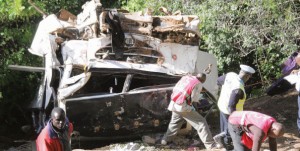 More than 3,000 people die every year in traffic accidents on Kenyan roads. That number could double by 2020 if nothing is done now to stop the carnage.
More than 3,000 people die every year in traffic accidents on Kenyan roads. That number could double by 2020 if nothing is done now to stop the carnage.
The majority of road accidents on our roads are preventable. Poor road safety culture and failure to strictly enforce traffic rules are chiefly to blame for the high accident casualty rate.
Statistics indicate that Kenya has some of the highest road accident fatality rates globally. In 2009, for instance, Kenya recorded 10 deaths in road accidents for every 100,000 people, with 3,760 Kenyans perishing on our roads that year. Compare this to 3.2 deaths for every 100,000 people in Nigeria and Rwanda the same year.
Kenya recorded fewer deaths than Botswana and Thailand, which recorded 25 deaths per 100,000, Brazil (18.3) and US (13.9). But it was still ranked among countries with the most dangerous roads.
The International Federation of Red Cross and Red Crescent Societies estimates that more than 1.3 million people die in road crashes each year and more than 50 million injured. Globally, 3,500 people die in accidents every day.
The total cost of is $500 billion annually. (Sh40 trillion)
World Health Organisation figures reveal that 90 per cent of the road fatalities occur in low- and middle-income countries, home to less than half of the world’s registered vehicles. The number of road fatalities is set to double by 2020 globally.
Road accidents kill more people than tuberculosis and malaria in developing nations. They are the leading cause of death among young people aged 15-29, killing more youths than HIV/Aids in developing countries like Kenya.
WHO has singled out road accidents as a major public health problem in developing nations. Essentially, this means that the fatalities are no longer regarded as mere government statistics, but a serious public health and development challenge requiring urgent concerted global action.
A majority of the accidents involve matatus and now, increasingly, motor cycles popularly known as ‘boda bodas’. Incidentally, many Kenyan hospitals have now reserved special wards dedicated to patients nursing injuries from accidents involving ‘boda bodas’.
The fact is, many Kenyans rely on matatus and boda bodas to commute, hence the need for more energy and resources to be focused on enhancing safety in the public road transport system.
In May last year, the Decade of Action for Road Safety 2011-2020 was launched in more than 100 countries under the auspices of the United Nations. The ultimate goal of this campaign is to cut road traffic deaths globally by 50 per cent by 2020.
The Action Plan requires governments to implement road safety activities in each of the five pillars of the Global Plan for the Decade: road safety management; safer roads and mobility; safer vehicles; safer road users; and enhanced post-crash response.
It also calls for closer collaboration among governments, civil society organisations, academia, and the private sector in dealing with the road safety crisis.
In Kenya’s case, we could go a few steps further by seeking to change our road culture. Improving road safety has to start with the individual. Attitudinal shifts are required to instil in Kenyans a culture of safe road usage.
It entails observing speed limits, proper vehicle maintenance, and respecting other road-users including cyclists and pedestrians.
Leading the way, several private sector players have partnered with the government to launch a nationwide campaign on road safety. They have formed the National Road Safety Trust to spearhead countrywide initiatives with a view to reducing the alarmingly high rates of fatalities in Kenya.
At a stakeholders workshop held recently to chart a roadmap for the Trust, participants advocated for a change in road safety behaviour as well as advanced educational programmes targeting motorists especially in the public transport industry.




![Top 20 Used Cars to Avoid Buying in Kenya – [PHOTOS]](../../../blog/wp-content/uploads/2013/11/top-used-unreliable-cars-to-avoid2-80x60.jpg)


![Here are some of the best tuned cars in kenya by state of the art garages [PHOTOS]](../../../blog/wp-content/uploads/2013/11/29402_10151301757042065_340470732_n-e1384498044289.jpg)

![Top 20 Used Cars to Avoid Buying in Kenya – [PHOTOS]](../../../blog/wp-content/uploads/2013/11/top-used-unreliable-cars-to-avoid2-100x70.jpg)



